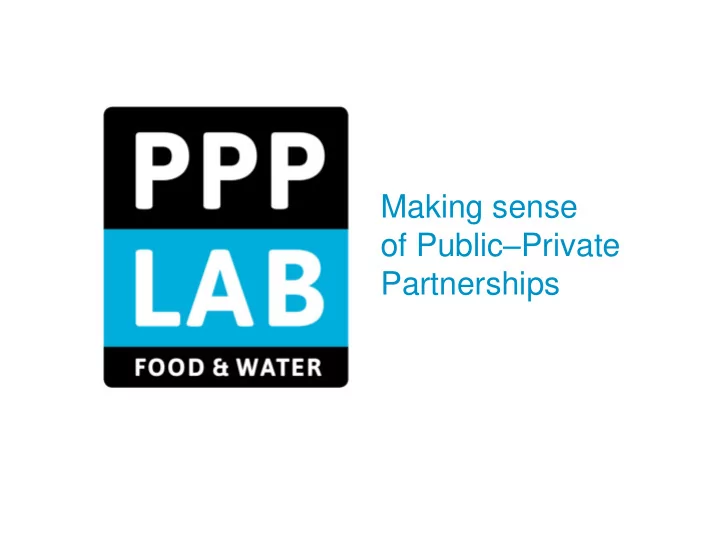

Making sense of Public – Private Partnerships
PPPLab B4 Study: Business Models in Food & Water PPPs First findings of 2012 FDOV & FDW project proposals
Objectives & Methodology of the study Objectives Generate lessons learned about the business models of the PPPs and their financial strategies • Aim for inclusiveness • Role of the business case in the PPP • Risk analysis & allocation Methodology Quick scan of all 42 project proposals (29 FDOV and 13 FDW) • Motivation & type of activities • Relation between project and underlying business • Inclusiveness of the business model Business Model Generation Methodology adapted for PPPs in development sector Review of risk profiles of PPPs 3
Quick Scan findings Motivation of main partner 4
Quick Scan findings Type of activities of the PPPs 5
Quick Scan findings Partners, their motivations and types of activities • Only half of the PPPs specifically aim to generate return on investment • Much more innovation in FDOV than FDW • HRM/ Intrinsic motivation strong driver in FDW (Dutch water utilities) • Strong emphasis on training/ capacity building an technology • Much less for marketing and policy/ advise 6
Inclusiveness of the BoP • High Is the leading private sector having a income strategy for this group? • Which sub-category of low-income groups? • How are they integrated in your Middle income business operation? • Are local SME involved? Low income 7
Quick Scan findings Explicit strategy towards BoP 8
Quick Scan findings Active involvement of the BoP 9
Quick Scan findings Position of the business case in the PPPs Three types identified: 1. The project = the business case. (7 FDOV, 6 FDW) 2. The PPP initiates and/or supports multiple business cases. (10 FDOV, 1 FDW) 3. The PPP supports a far larger business case of one of the partners . (14 FDOV, 6 FDW) 10
Relations between the projects and business models The project FDOV12BI01 FDW12GH06 FDOV12ET06 FDW12KE03 FDOV12GH01 FDW12OT01 FDOV12KE01 The Business case FDW12SA01 FDOV12KE09 FDW12SL01 FDW12TZ02 FDOV12RW04 FDOV12KE02 7 6 The project = the business case 11
Relations between the projects and business models FDOV12KE03 FDOV12KE06 The project FDOV12KE04 FDOV12ML01 FDOV12MZ04 Business FDOV12TZ01 case Business FDOV12TZ03 case FDOV12TZ04 Business FDOV12PH01 case FDOV12KE02 FDW12ET06 1 10 The project supports or initiates multiple business cases 12
Relations between the projects and business models The project supports a (far) larger business case of 1 The project or more of the partners The Business case FDOV12CG01 FDOV12MW01 FDW12CO01 FDW12ET03 FDOV12CO03 FDOV12NI01 FDW12GH02 FDOV12RW02 FDOV12ET01 FDW12MW01 FDOV12ET05 FDOV12RW04 FDOV12ET09 FDOV12SA03 FDW12RW01 FDW12BD03 FDOV12GH07 FDOV12VN03 FDOV12RI07 FDOV12VN05 6 14 13
Business Model Generation methodology Source: http://www.businessmodelgeneration.com/canvas/bmc 14
“ PIB Scan ” Assessment Tool for P PP I nclusive B usiness A potential tool for indicating PPPs’ potential sustainability perspectives from a private sector perspective 15
PIB Scan based on Business Model Generation methodology Crucial ! ! 16
4 Fields added to original methodology > Governance of the partnership • because in a PPP this is a crucial point of attention > Extended beneficiaries • to better capture the developmental impact beyond the direct customers > Social and environmental impact • besides the economic return, again to highlight the developmental relevance > Business Ecosystem (enveloping around the whole canvas) • to capture factors beyond the PPP’s reach (e.g. legal or institutional framework, regulations) but that could greatly influence the PPP and bring additional risks 17
Business Ecosystem What strengthening strategies are used to influence the business-ecosystem? How does the business address barriers to doing business and to scale? (e.g. limited knowledge and skills among the BoP; lack of market information; ineffective regulation; inadequate infrastructure; limited access to finance) How is the business embedded in local structures? Partners Key activities Value proposition Customer relationships Customer Extended Who are the key partners What key activities are What value is delivered to the What type of relations are Segments beneficiaries for the business? required for: customers? established with each For whom is Who benefits Who are the key suppliers? - creating the value Which of the customer's customer segment and how value created? from the Which key resources are proposition? problems is it solving? are they maintained? Who are the business besides acquired from partners? - operating the What combinations of How are these integrated in most important the customers? Which key activities do distribution channels? products and services are the rest of the business customers? What are the partners perform? - maintaining customer offered to each customer model? most important relationships? segment? How costly are they? groups - managing revenue Which customer needs are identified? streams? satisfied? Who are the Partnership Governance Key resources Channels customers of my Who took the initiative for What key resources Through which channels customers? the partnership? are required for: are customers reached? Who is leading the - creating the value How are these channels partnership? proposition? integrated? Which partners are crucial, - operating the Which ones work best and will cause the business to distribution channels? which are most cost- fail when they move away? - maintaining customer efficient? How is the partnership relationships? How are these (being) organised, structured? - managing revenue integrated into customer How does the partnership streams? routines? deal with unforeseen circumstances? Cost structure Impact Revenue streams What are the most important costs inherent to the What impact (social, For what value are the customers willing to pay? business model? environmental, economic) is For what do they allready pay and how? Which key resources are most expensive? generated? How would they like to pay? Which Key activities are most expensive? What sustainability issues are How much does each revenue stream contribute to the overall addressed or solved? revenues? 18 This extended Business Model Canvas is based upon the Business Model Canvas as developed by Strategyzer.com
Recommend
More recommend